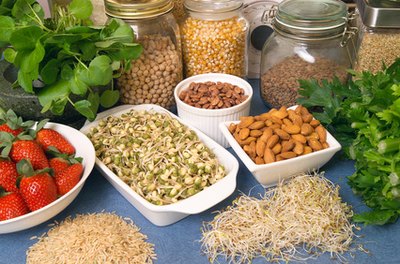With well-planned meals, vegetarians who eat eggs and dairy, and vegans who stay away from all animal products, can enjoy a nutritionally balanced diet. Many vegetarians rely on grains, particularly wheat, for energy, B vitamins and protein. If you are unable to eat the protein in wheat, barley and rye, known as gluten, because of celiac disease or an intolerance, you can still live a vegetarian lifestyle. Create meal plans that revolve around naturally gluten-free foods such as fruits, vegetables, beans, nuts, seeds and alternative grains.

Fruits, greens, nuts, sprouts and rice are staples on a vegetarian gluten-free plan. Photo Credit healthy foods image by Steve Lovegrove from Fotolia.com

Ovo-Lacto Plan
Ovo-lacto vegetarians consume eggs and dairy, but no meat, fish or poultry. Start with a breakfast of scrambled eggs, for vitamin B-12 and protein, along with a glass of calcium-enriched orange juice. Have two slices of toast made with buckwheat bread and 1 tbsp. of fruit spread on the side. At lunch, top brown rice with canned refried beans, salsa, sliced avocado and low-fat sour cream. For dinner, boil rice pasta and top it with low-sodium marinara sauce and shredded mozzarella cheese. Snacks during the day might include rice crackers with cheese, nuts, fresh or dried fruit and cut-up veggies with hummus.
Lacto-Plan
A lacto-vegetarian consumes dairy, but no eggs or meat. Make pancakes with a gluten-free baking mix, water, olive oil and 1 tbsp. of flax seed meal soaked in 3 tbsp. of water in lieu of the egg. Top with fresh fruit and agave nectar. At lunch, make a salad of cottage cheese, chopped cucumber, chopped tomato and chopped bell peppers. Have with a bowl of tomato soup. For dinner, make black bean tacos topped with shredded cheddar cheese and salsa on corn tortillas. Snacks include yogurt, nuts and puffed millet cereal with low-fat milk.
Vegan Plan
A vegan plan is the most restrictive vegetarian plan as it includes no milk products, eggs or meat. A smoothie is a good way to fit in extra nutrition without gluten. Blend together a frozen banana, calcium-enriched soy milk, almond butter and frozen peaches. For lunch, have a bowl of lentil soup with a salad of cooked quinoa, white beans, lemon juice, olive oil, cilantro and chopped tomatoes. At dinner, broil portabella mushrooms and serve them over a salad of baby spinach, roasted red peppers, grilled red onion and toasted pecans. Have this with white rice and tapioca flour rolls. Snacks might include fresh fruit, soy yogurt, popcorn with nutritional yeast and nut butter on celery or apples.
Considerations
Consult with your physician or dietitian to make sure your day-to-day gluten-free, vegetarian meals supply sufficient nutrition. Vegetarians are sometimes deficient in zinc and vitamin B-12. Many enriched-wheat products, such as cereals and bread, are important sources of these nutrients for vegetarians and vegans. Because a gluten-free diet does not include these foods, you may need a supplement. Common vegetarian foods, specifically tofu, seitan, textured vegetable protein and processed veggie burgers and sausages often include wheat in the ingredients. If you choose to include these foods as part of your diet, be sure to read the ingredient lists carefully.
www.livestrong.com





No comments:
Post a Comment